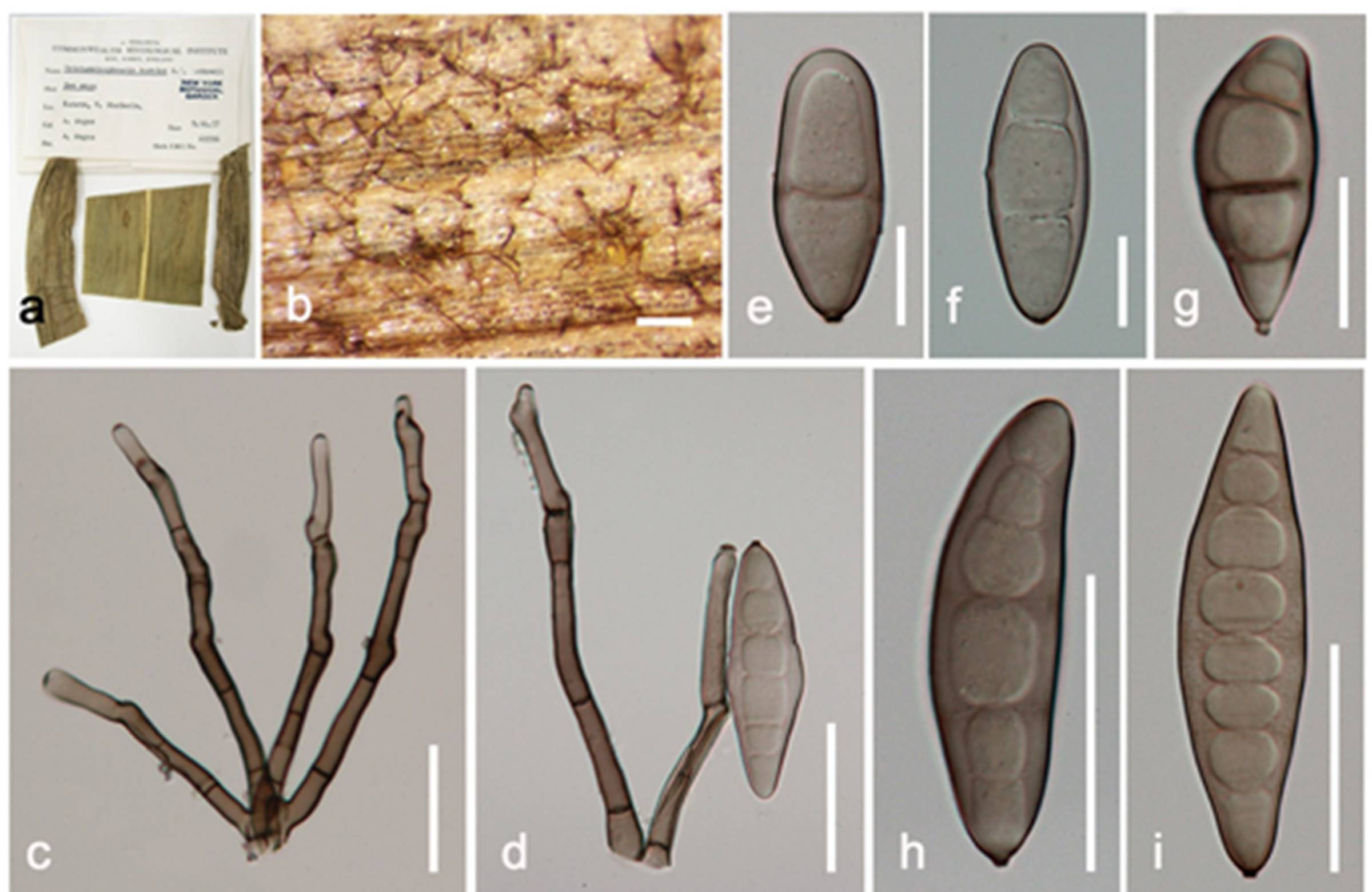Exserohilum turcicum (Pass.) K.J. Leonard & Suggs, Mycologia 66(2): 291 (1974)
≡ Helminthosporium turcicum Pass., Boln Comiz. Agr. Parmense: 3 (1876).
≡ Bipolaris turcica (Pass.) Shoemaker, Canadian Journal of Botany 37 (5): 884 (1959).
≡ Drechslera turcica (Pass.) Subram. & B.L. Jain, Current Science 35 (14): 355 (1966).
≡ Luttrellia turcica (Pass.) Khokhr., Vodorosli, Griby i Mkhi Dal’nego Vostoka: 81 (1978).
= Helminthosporium inconspicuum Cooke & Ellis, Grevillea 6 (39): 88 (1878).
= Trichometasphaeria turcica Luttr., Phytopathology 48(5): 282 (1958).
Pathogenic on living leaves of Zea mays. Sexual morph: not observed. Asexual morph: Conidiophores (111-)147–164(-215) × 7.3–8.5(-11) µm (x̅ =158 × 8.2 µm, n = 20) erect singly or in groups of 2-5, long, straight or flexuous, cylindrical, unbranched, or branched below, 2–5-septate, grayish brown to brownish grey, inner wall layers of conidiogenous cell are continuous with the conidial wall, pale to medium brown Conidia (41-)112–127 × (17-)22–23(-29) µm (x̅ = 99 × 23 µm, n = 20), ellipsoid-fusiform, widest at the middle and tapering toward ends, long, straight or slightly curved, 2–8-distoseptate, some euseptate, grayish-brown, thick-walled, smooth, scars thickened.
Material examined: ZAMBIA, Katete, North Rhodesia, on living leaves of Zea mays, collected by A. Angus, 9 February 1957, determined by A. Angus, obtained from NY (Ex herbarium: IMI 69726).
Notes: The genus Exserohilum was proposed by Leonard & Suggs (1974) to accommodate species which were previously classified in Bipolaris, in which the conidial hilum was distinctly protuberant. In the same study, Leonard and Suggs (1974) introduced a new genus Setosphaeria to place the sexual stages of Exserohilum, which is segregated from Keissleriella on the basis of lack of a clypeus, lysigenous development of the ostiole, occurrence of setae on the perithecial wall, the absence of periphyses in the ostiole and the hyphomycetous conidial states. As a genus can now only have one name, Wijayawardene et al. (2014) proposed to conserved Exserohilum over Setosphaeria on the basis having of more epithets (Index Fungorum 2014), and is more widely use in the literature.
During our phylogenetic study putative strains of Exserohilum monoceras (= Setosphaeria monoceras CBS 154.26), Exserohilum sp. (C950801) and Exserohilum sp. (NK93) formed a well-supported clade sister to Curvularia. Therefore based on phylogeny and morphology we accept Exserohilum as a separate genus in the family Pleosporaceae.
Fig 1 Exserohilum turcicum (holotype). a. Herbarium material. b. Conidiophores and conidia on leaf surface of Zea mays. c. Conidiophores. d. Conidiophore and conidium. e. I Immature and mature conidia. Scale bar: b = 200 µm, c, d, h, i = 50 µm, e-g = 20 µm

